 Loading... Please wait...
Loading... Please wait...Free Shipping on orders over $500
Categories
Surgical Lights Buyer's Guide For Medical Professionals, Surgery Centers, Medical Offices and Hospitals
Posted on 07/24/2018 09:56:00

For many doctors, hospitals, medical offices and surgical centers, selecting the best surgical lighting for your budget is a complex and time-consuming project. There are many options to choose from and advancements in technology bring significant improvements that help the surgeon and surgical team operate with great visibility. Improved brightness, better light color, and lower heat are several benefits that improve the operating theater and help the surgical team with surgical procedures. Advancements in medical procedures, such as keyhole surgeries and endoscopic techniques, also require better medical illumination systems. Every light used for surgical purposes must adhere to certain requirements in terms of luminance, color, and other variables. This buyer’s guide highlights the main product features and the benefits they bring to the surgeon and the surgical team to help buyers make informed decisions and save time.
The lighting in most operating rooms is a combination of ambient lighting and surgical lighting. It is critical that your new surgical lighting system provide great lighting and the best environmental conditions for the operating field such as low heat and ease of use. It has been reported that around 20 percent of surgical time goes into adjusting the surgical lights in the operating room. Modern operating rooms have advanced significantly beyond simple, single-procedure rooms. Today’s operating rooms have become highly technical multi-functional rooms capable of a wide variety of procedures within a single space, complete with multiple devices, video routing systems, and digital imaging. Surgical lighting can be installed on ceilings or walls and most manufacturers offer portable floor stand models.
Before purchasing surgical lights, it’s important to consider the following:
- What are Surgical Lights and How Do they Work?
- How Much Do Surgical Lights Cost?
- Surgical Light Technology
- Main Specifications to Consider When Investing in Surgical Lighting
- Additional Factors to Consider When Purchasing Surgical Lighting
- Power Backup for Surgical Lighting
- Integrating Surgical Lighting into your Operation Room Effectively
- Uniform Lighting or Discipline-Specific Lighting?
- Financial Factors and Total Cost of Ownership
Additional purchasing considerations for some medical facilities are:
- Mobile Surgical Lights: Surgical Lights on Wheels
- Surgical Headlights
- End of Life Disposal of Surgical Lighting
- The Future of Surgical Lighting
- Placing a Surgical Light Order
What are Surgical Lights and How Do They Work?
Surgical lights are referred to by many names: Operating lights, OR lights, operating room lights, surgical lamps, and surgical light heads. Surgical lights are medical equipment devices used to illuminate the operating field during surgery. A group of surgical lights providing lighting in the operating theatre is often referred to as a surgical light system.
Surgical lights provide the surgical team with bright, consistent lighting focused on the operation table during surgery. Surgical lights can be categorized based on the light type as either incandescent (conventional) or LED lights. Conventional surgical lights are basically gas-filled incandescent lights that contain halogen at a certain pressure setting. Light-emitting diode (LED) lights have been a revolutionary improvement in the field of surgical lighting, virtually eliminating the problem of infrared radiation caused by excessive heat. Surgical lights can also be categorized based on mounting configurations such as ceiling mounted, on-floor or portable lights, and wall-mounted lights.
How Much Do Surgical Lights Cost?
Surgical lights are priced anywhere from $2,000 to over $40,000. The price depends on many variables and options. Do you need a portable floor light or a ceiling mounted light system with multiple lights? The number of surgical light heads and optional imaging equipment are the most important factors for price. Modern surgical lights are available with a range of accessories that can increase the price. HD video cameras, HD monitors, and power backups are a few options that are typically purchased with a multi-arm ceiling-mounted light system.
The lifespan of surgical lights typically ranges from 10-12 years or longer with the new LED light sources. With LED surgical lights, the chances of replacing the bulbs are quite slim, but if they ever do need to be replaced due to damage or inefficiency, it can be costly. Replacing halogen lights typically cost about $100 to $300 each and spares need to be in stock and nearby. The costs for incandescent lights may increase in coming years as manufactures shift production to LED light sources. Surgical lights are an important investment and asset for medical facilities and it is important to buy a brand that has a comprehensive multi-year warranty. In some cases, extended warranties can be purchased.
Surgical Light Technology
Lights used in surgical lights are typically incandescent lights or light-emitting diodes (LED). Incandescent lights resemble typical domestic light bulbs that emit light from a filament, glowing in a gas-filled glass chamber. The filament is usually made of tungsten. The type and proportion of gas in the bulb varies. Incandescent lights do not last as long as LED lights and they may need to be replaced during a surgical procedure.
In recent years, surgical lights were available with metal-halide bulbs. Metal-halide lights are more efficient than incandescent bulbs and produce a brighter light. These bulbs generally last longer than incandescent bulbs. A major drawback to metal-halide lights is they require a 5-7-minute warmup period. In contrast, LED lights immediately reach their light output. Another disadvantage of metal-halide lights is they contained hazardous mercury.
LEDs are the current state-of-the-art light source for surgical lights. LED lights relies on a semiconductor technology and have many advantages over incandescent bulbs.
Benefits of LED Surgical Lights
- Brighter white colors
- More accurate colors
- Significantly more energy efficient
- Last much longer (20x-30x longer)
- Emit virtually no heat
Main Specifications to Consider When Investing in Surgical Lighting
All surgical lights must comply with the technical requirements set by the International Electrotechnical Commission (IEC). Some of the most important characteristics of the lighting performance are color rendition, color temperature, and illuminance.
Illuminance/Light Output (40,000 – 160,000 lux) is the measurement of how much light falls on the surface per square meter. The units of light eliminated by surgical lights are measured in lux with a lux meter. This is measured at 1m for surgical lights. According to the International Electrotechnical Commission (IEC), the illuminance of the operating cavity should be within the 40,000 - 160,000 lux range. In contrast, the requirement for the reading light in the patient’s room is 300 lx, for examination light – 1000 lx.
Color Temperature (3,000 – 6,700 K) is the measurement of the light source’s color relative to an ideal light source. The unit of measurement for color temperature is Kelvin. The measurement of daylight color temperature is around 5,800 K. The IEC requires the color temperature of surgical lights to be within the 3,000 – 6,700 K range.
Warmer colors (yellows and reds) appear at lower temperatures, while cooler colors (white and blue) appear at temperatures above 5,000 Kelvin. For a quick comparison, light from a candle is around 1,800 K, a soft white incandescent light bulb is around 2,500 K, and direct daylight white is approximately 5,800 K.
Halogen lights generally have a color temperature around 4,000 K. Some halogen lights produce a higher color temperature. However, as the color temperate increases the heat emissions increase as well. In contrast, LEDs work independently of heat and color. LEDs have a color temperature around 4,300 K to 4,500 K. Maintaining optimal color temperature is critically important, as it influences the color and rendition of body tissue and fluids.
Color Rendition (85 – 100) is the measure of quality of light and it is often referred to as the color rendering index (CRI). Natural colors of objects are best visualized under the bright daylight, to which lighting devices are compared (reference value of 100). Lights with “good” color rendition have a CRI over 80. Lights with very good color rendition have a CRI over 90. Often regular lighting can distort the color and appearance of objects, something that must be avoided during a surgical procedure. Therefore, the IEC has mandated that the color rendition index (Ra) for surgical lights needs to be between 85 and 100.
Additional Factors to Consider When Purchasing Surgical Lighting
Radiating Heat: Traditional lighting systems produce higher levels of heat which can cause discomfort for the surgeons and dry out exposed tissues, potentially impacting patient care and recovery. Heat radiation also interferes with the laminar airflow in operating rooms, which helps to reduce bacterial organisms in the surgical area by generating continuous bacteria-free airflow in a certain direction. Filters and lenses are often employed, which allow light but block heat emissions. LED surgical lights are a good investment since they produce virtually no heat, while on the other hand, halogen lights dissipate much higher levels of heat.
Shadows & Glare: Shadows are cast from the surgeon’s head, arm, or body as well as the surrounding medical team during the surgery. The latest lights use multiple light sources that can be easily cross-focused to virtually eliminate shadows.
Glare can originate from the light source or it can be a reflective glare from other surfaces illuminated by the surgical lights. Glare can cause eye fatigue and momentary vision blurring. Precautions should be taken regarding the angles and placement of reflective surfaces in the operating room to eliminate glare factors.
Surgical Light Field Diameter: Surgical lighting should have the ability to adjust to a wide range of light fields. A light field diameter of D10 is the diameter of light field around the light center, where the illumination is 10 percent Ec. A light diameter of D50 should not exceed 50% of a D10 diameter. The illustration below represents this functionality. The smaller arrow is D50 while the larger arrow is D10. This simply means that 50 percent of the entire pie of light intensity should fall within 50 % of its total diameter.
Surgical Light

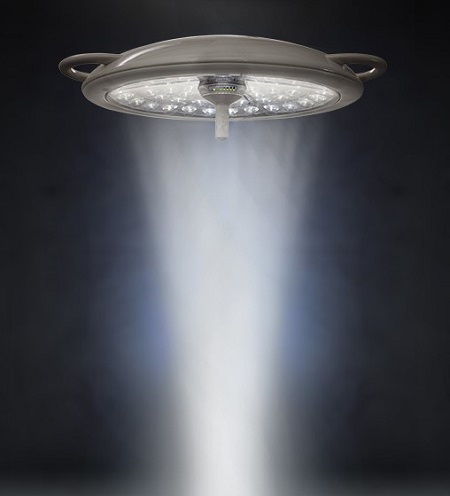
Single Surgical Light Head or Multiple Surgical Light Heads
Surgical lights are available in a variety of designs, including models with a single large light head or multiple smaller light heads. Although luminaires with a single light head may provide sufficient light output, having multiple light heads may provide better adjustability. Lighting equipment should be designed to produce no shadow, which is easier to achieve with “major” and “satellite” light heads, but is also attainable using a single light head with a peripheral reflector or prismatic optical system.
Infection Control
Maintaining a clean, sterile environment in the operating room theater is imperative for infection control and patient care. Many new surgical lights support sterilizing via multiple cleaning procedures. With continuous adjustments made to operation room lighting during surgery, sanitization becomes a necessity. Surgical light manufacturing must also ensure minimum crevices and dust-friendly surfaces to minimize cleaning efforts. Disposable light covers are usually available for most surgical lighting units. Many surgical lights such as the Medical Illumination System Two LED Surgical Lights , have removable, sterilizable handles making them easy to clean and sterilize.
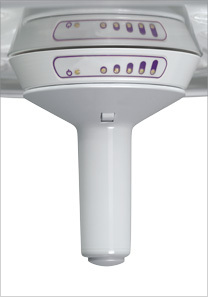
Integration with High-Definition Imaging Equipment
A major factor influencing the purchase decision of surgical lights is the ability to support and blend with audio/visual equipment. When purchasing OR lights, interaction between AV equipment, other operating room equipment, and lighting systems should be considered. Many ceiling-mounted surgical lights can be configured with multiple arms that can support additional surgical light heads, high-definition monitors, and high-definition video cameras. High-definition monitors provides a variety of options to connect a HD monitor to a video source or video switch. Most surgical light manufacturers provide high-definition camera options. The HD cameras generally feature multiple optical and digital zoom options and the functionality to have auto and manual focus. These HD cameras provide standard HD video outputs to connect to computer systems or a monitor on an adjacent arm.
When choosing surgical lights systems, it is important to find one that strikes a balance between technical advantages, features, and price. A good example of this is the Medical Illumination System Two LED Surgical Light. It is a great fit for a wide range of surgical procedures and it is very affordable.
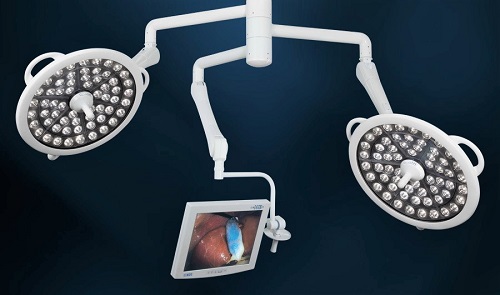
Power Backup for Surgical Lighting
While most electrical sources are reliable, they can experience outages and power interruptions shutting off the surgical light. The IEC mandates that in case of a power supply interruption, lighting in an operating room should be restored within five seconds and maintain at least 50 percent of the previous lux intensity, which cannot be less than the minimum requirement of 40,000 lux. Complete restoration of the surgical lighting required must occur within 40 seconds of the interruption. For that reason, it is unacceptable to run all surgical lighting equipment from a single power source. Many surgical lights are available with a backup power source in case of power interruption.
Some of the most important technical and operational requirements for surgical lights are summarized in the following table. Data for examination lights are given for comparison.
Technical and operational guidelines for surgical and examination lights.
| Requirement | Examination lights | Surgical lights | |
| Minor surgery | Major surgery | ||
| Fail safe | No | No | Yes |
| Color rendition (CRI) | 85 – 100 | 85 – 100 | 85 – 100 |
| Color temperature (K) | 3,000 – 6,700 | 3,000 – 6,700 | 3,000 – 6,700 |
| Illuminance (lx) | 1,000 | 40,000 – 160,000 | 40,000 – 160,000 |
| Sterilizable handles | No | Yes | Yes |
| Shadowless | No | Yes | Yes |
Integrating Surgical Lighting into your Operation Room Effectively
It is important to invest in surgical lights that can fit well with your operating room in terms of space utilization, human ergonomics, technology, audiovisual equipment and the electrical system. Mobility, portability, and the right accessories for OR lights are important factors for ensuring return on investment, medical staff satisfaction, and patient care. One measurement often overlooked is the ceiling rod height. Ceiling rod height is an important factor for optimal light positions and ergonomics, and the correct length needs to be acquired when the light is purchased. The ceiling rod length needed depends on the height of the ceiling where the surgical light will be mounted.
Many surgical light manufacturers offer optional touchscreen wall controls. These touchscreen wall controls provide the surgeon and the surgical team with easy remote management of lighting features.
The advancements with surgical lighting arm systems provides the surgeon and surgical team with unprecedented ease of use. Single, dual, and triple mount arms provide tremendous flexibility in how the operating room is equipped and merged with the latest imaging technology. Surgical light suspension arms are precision-balanced and articulated to allow the greatest reach and range of positioning with surprising ease.
Uniform Lighting or Discipline-Specific Lighting?
A major aspect to consider when selecting surgical lights is whether the lighting equipment will be uniform across all surgical suites or whether it needs to be discipline-specific. This is especially important for large hospitals and outpatient surgery centers with multiple surgery departments. Investing in identical light systems will usually keep installation and maintenance costs lower. Uniform lighting also helps the medical staff seamlessly transition between operating rooms.
Financial Factors & Total Cost of Ownership
Surgical lighting systems are a large investment for hospitals and medical centers. While cost is an important determinant of a purchase decision, it is also important to consider the total cost of ownership involved.
Some factors to consider are:
- Whether the surgical light is manufactured under a modular system, which is easier to update as different parts can be replaced rather than the entire system
- Quality of the optics and light intensity over the life of the light head
- The versatility of the light head, as surgical procedures constantly evolve with updated technologies
- Does the lighting system meet the clinical objectives
- Installation and maintenance costs involved with the light head across its lifespan. Service contracts can also be entered with the manufacturer or third-party organizations.
- Operating cost of the light head day in and day out
- Gains in efficiency and operating costs which come with improved lighting technology
- Warranty length
Many lending companies offer financing and leasing options for medical equipment, including surgical lights. USA Medical and Surgical Supplies also offers financing options with payment plans ranging from one to five years.
Mobile Surgical Lights: Surgical Lights on Wheels
Most surgical light manufacturers have portable surgical light models. The portable surgical lights are the same light head (from that product line) mounted onto a wheeled frame which allows them to be easily moved in the operating room theater for better light positioning or additional lighting. Many portal surgical lights can be ordered with optional battery backups.
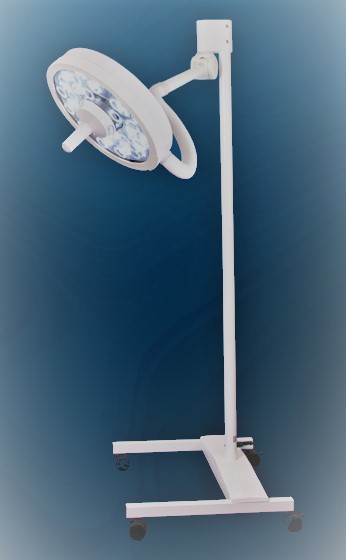
Surgical Headlights
Wearable surgical lights provide the surgeon with ultimate mobility and precision. The Coolview 1400-XT is an excellent LED Surgical Headlight featuring an incredible 140,000 lux intensity. Light color temperature matches natural daylight by operating at 6,500 degrees Kelvin. Coolview has patented the technology that allows the 1400-XT to maintain a bright white light while operating on rechargeable batteries, eliminating the need for cables. The battery is unobtrusively attached to the surgeon’s belt, ensuring any operational heat is not in proximity to the surgeon’s face or head.
The Coolview headset only weighs 6 ounces, while the battery pack attached to the belt weighs only 9 ounces. Extra batteries and chargers are also available. Each battery takes 4 hours to charge and operates a very bright light for approximately 4 hours.
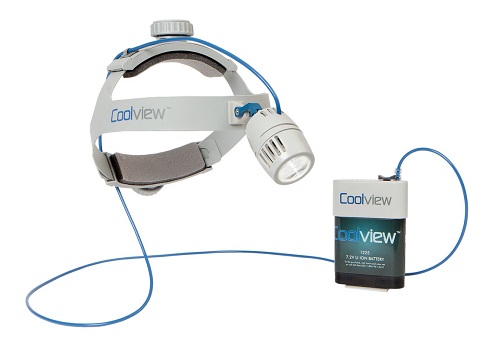
End of Life Disposal of Surgical Lighting
Environmental and financial factors control the disposal of surgical lights at the end of their lifespan. Certain surgical light manufacturers allow you to return used surgical lights when they have reached the end of the working lifespan. Alternatively, you can also dispose of surgical lights based on your local regulations. Laws vary from country to country concerning the disposal responsibility between the manufacturer and final user.
The Future of Surgical Lighting
The field of surgical lighting has changed immensely as technology has advanced and imaging has improved. As medical science progresses, it is imperative that surgical lighting requirements and specifications constantly evolve as well. Some avenues being explored in the field of surgical lighting include cold-mirror technologies that separate infrared from non-infrared radiations, creating a more cost-effective surgical lighting solution.
As virtual reality technology improves, the ability for 3D modeling will become more accessible to hospitals and other medical facilities. Creating a 3D model of your operating room would help check for health and safety issues regarding cabling, connections, and hardware. The OR environment is highly susceptible to electrical accidents with a high number of electrical equipment and fluids such as urine, blood, and saline. These combinations pose a big risk to safety. A comprehensive 3D model would help you eliminate any risk factors.
Future technological advancements will also include lighting that senses an obstruction or human movement, and auto-adjusts to regain maximum visualization for the medical team. These advancements will prove to be greatly beneficial and reduce surgery time, creating a safer operating environment for both surgeons and patients.
Medical Illumination Surgical Lights
Medical Illumination specializes in high quality medical LED lights for operating rooms, exam rooms, and veterinary facilities. A leading manufacturer of surgical lighting for over 30 years, Medical Illumination products are well known for their superior engineering combined with innovative cost effectiveness.
The MI-750 LED Surgical Light is a popular model due to its quality, efficiency, and value. Primarily used for medical exams, general procedures, and minor surgery, the MI-750 has an output rating of 75,000 lux at 1 meter, and a color temperature of 4,300 degrees Kelvin. The LED lights emit virtually no heat, and can be mounted on the ceiling, wall, and available in a portable model.
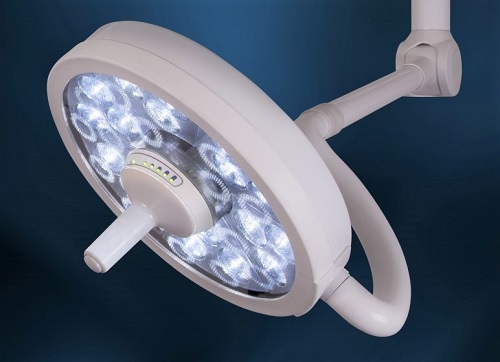
The Medical Illumination MI-1000 LED Surgical Light is a popular light from Medical Illumination. The light produces 100,000 lux with a color temperature of 4,300 degrees Kelvin. Designed with "Green" innovation, the MI-1000 uses altogether less power than standard incandescent lamps. The long-life LED's are evaluated at 50,000 hours for all intents and purposes disposing of the requirement for badly arranged globule changes. Five power yields are accessible and are controlled utilizing the five-stage dimming and on/off switch situated on the sterilizable handle. The MI-1000 LED is accessible in an assortment of mounting styles and all lighting hardware.
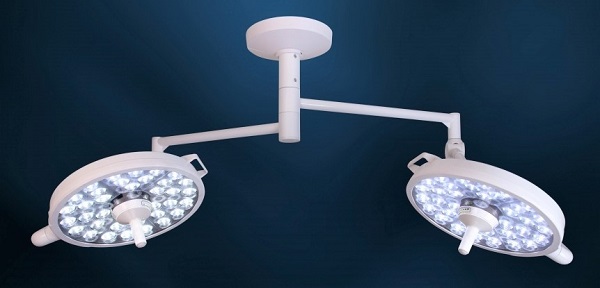
The System Two LED surgical light is a great option for surgical lighting in multi-specialty hospitals integrating lighting with visualization and controls systems. The System Two LED Surgical lights are some of the brightest surgical lights available. The System Two LED Surgical lights are highly efficient and consume half the electricity of standard halogen lights. With an estimated life of 50,000 hours these lights will last for years. The System Two LED Surgical lights have a light output of 130,000 lux with a color temperature of 4,300 degrees Kelvin. With excellent shadow control and the unmatched Medical Illumination suspension arm the System Two LED Surgical lights are ideal surgical site visibility and light positioning.
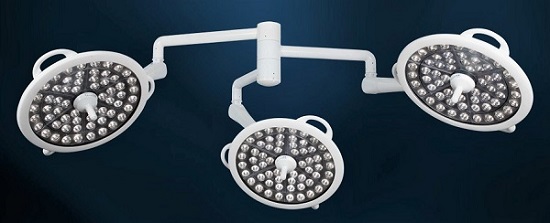
Placing a Surgical Light Order
We realize that choosing a surgical light is an important decision, and we’re here to help. Our trained staff is ready to answer your questions and provide you with first class service. Financing is available for medical equipment and is 100% tax deductible according to the US IRS.
If you’re interested in purchasing surgical lights for your facility, contact us today by calling 1-866-561-2380, or send an email. We look forward to working with you.




